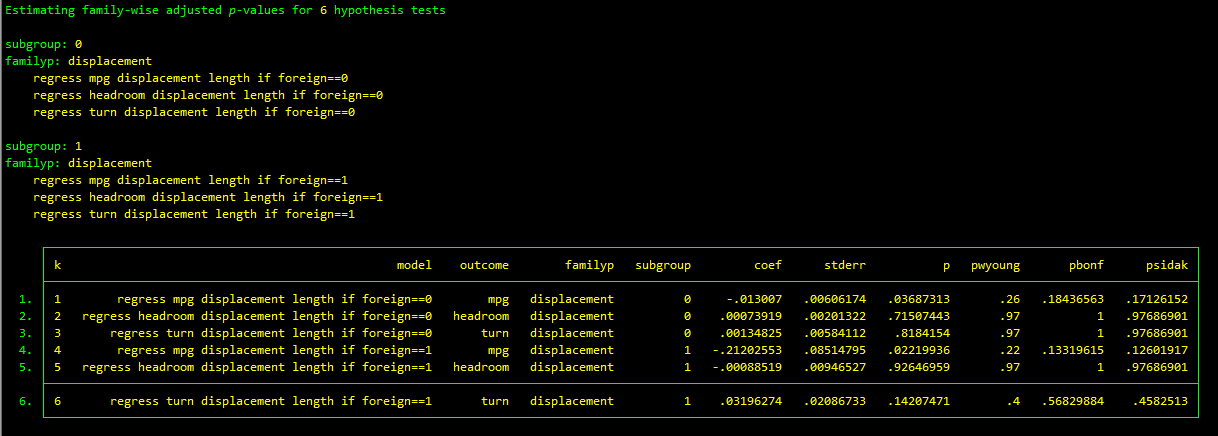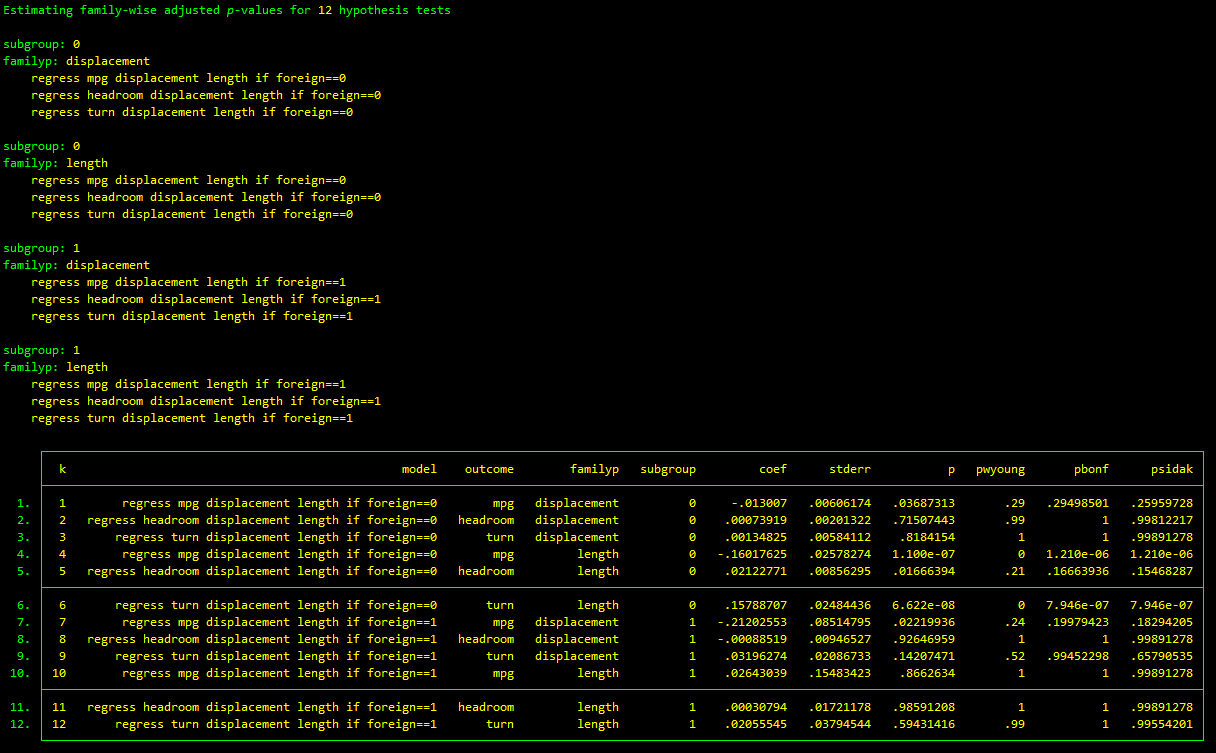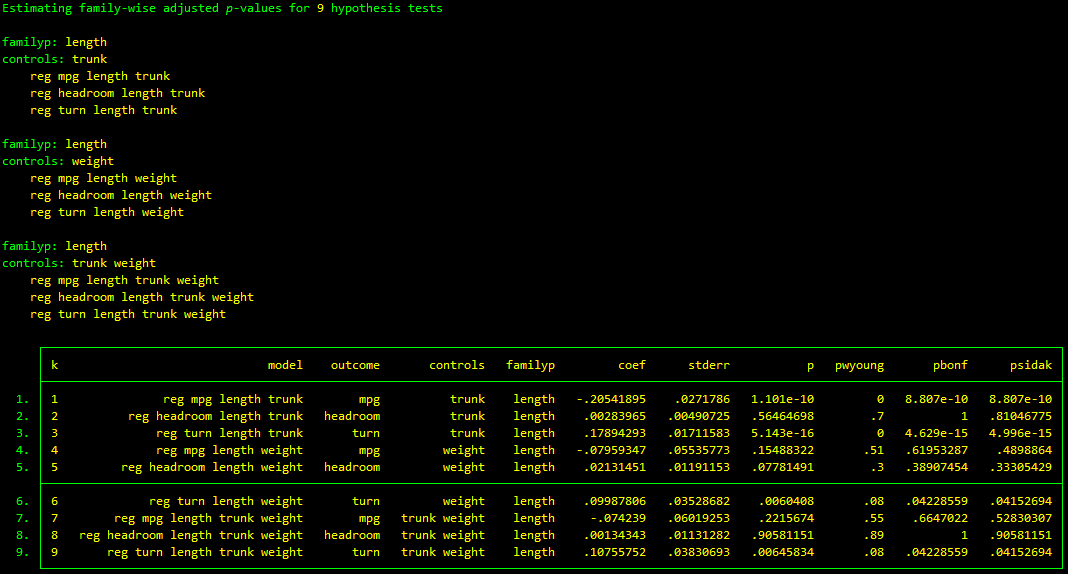- Current version:
1.3 29oct2020 - Jump to:
overviewinstallationexamplesupdate historycitation
wyoung is a Stata command that calculates adjusted p-values using the free step-down resampling methodology of Westfall and Young (1993). It also computes the Bonferroni-Holm and Sidak-Holm adjusted p-values. Algorithm details and simulation test results are documented here.
This command was developed as part of the Illinois Workplace Wellness Study.
Type which wyoung at the Stata prompt to determine your current version number. To install the most recent version, copy and paste the following line of code:
net install wyoung, from("https://raw.githubusercontent.com/reifjulian/wyoung/master") replaceTo install the version that was uploaded to SSC, copy/paste the following line of code:
ssc install wyoung, replaceAfter installing, type help wyoung to learn the syntax.
# R code
print("Hello World!")
sort(x, decreasing=TRUE)
# Program to check if the input year is a leap year or not
year = as.integer(readline(prompt="Enter a year: "))
if((year %% 4) == 0) {
if((year %% 100) == 0) {
if((year %% 400) == 0) {
print(paste(year,"is a leap year"))
} else {
print(paste(year,"is not a leap year"))
}
} else {
print(paste(year,"is a leap year"))
}
} else {
print(paste(year,"is not a leap year"))
}
Example 1. Estimate a model separately for three outcomes (mpg, headroom, and turn) and calculated adjusted p-value for displacement (3 hypotheses).
sysuse auto.dta, clear
set seed 20
wyoung mpg headroom turn, cmd(regress OUTCOMEVAR displacement length) familyp(displacement) bootstraps(100)For each regression, the output reports unadjusted and adjusted p-values for the null hypothesis that the coefficient on the variable displacement is equal to 0. For example, in the regression regress turn displacment length, the unadjusted p-value is 0.09 and the Westfall-Young adjusted p-value is 0.14.
Example 2. Estimate a model separately for three outcomes and for two subgroups defined by foreign (3 X 2 = 6 hypotheses).
sysuse auto.dta, clear
set seed 20
local yvars "mpg headroom turn"
wyoung `yvars', cmd(reg OUTCOMEVAR displacement length) familyp(displacement) subgroup(foreign) boot(100)Example 3. Estimate a model for three outcomes, for two subgroups defined by foreign, and calculate adjusted p-values for both displacement and length (3 X 2 X 2 = 12 hypotheses).
sysuse auto.dta, clear
set seed 20
local yvars "mpg headroom turn"
wyoung `yvars', cmd(reg OUTCOMEVAR displacement length) familyp(displacement length) subgroup(foreign) boot(100)Example 4. Estimate a model for three outcomes, for three different sets of controls, and calculate adjusted p-values for length (3 X 3 = 9 hypotheses).
sysuse auto.dta, clear
set seed 20
local yvars "mpg headroom turn"
wyoung `yvars', cmd(reg OUTCOMEVAR length CONTROLVARS) controls("trunk" "weight" "trunk weight") familyp(length) boot(100)Example 5. Estimate a model for three outcomes and test the linear restriction _b[length] + 50*_b[displacement] = 0 (3 hypotheses).
sysuse auto.dta, clear
set seed 20
local yvars "mpg headroom turn"
wyoung `yvars', cmd(reg OUTCOMEVAR displacement length) familyp(length+50*displacement) familypexp boot(100)-
1.3
controls()option added
-
1.2
familyp()option now supports multiple variables.subgroup()option added
-
1.1
familyp()option now supports the testing of linear and nonlinear combinations of parameters
-
1.0.5
familyp()option now supports factor variables and time-series operators
-
1.0.4
- Added support for commands that don't store p-values in
r(table)(egivreg2)
- Added support for commands that don't store p-values in
-
1.0.3
- Better error handling for missing observations
-
1.0.2
- Cluster bootstrap now required when clustered standard errors are present; force option added
-
1.0.1
- Cluster bootstrap option added
wyoung is not an official Stata command. It is a free contribution to the research community. You may cite it as:
Jones, D., D. Molitor, and J. Reif. "What Do Workplace Wellness Programs Do? Evidence from the Illinois Workplace Wellness Study." Quarterly Journal of Economics, November 2019, 134(4): 1747-1791.




